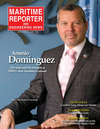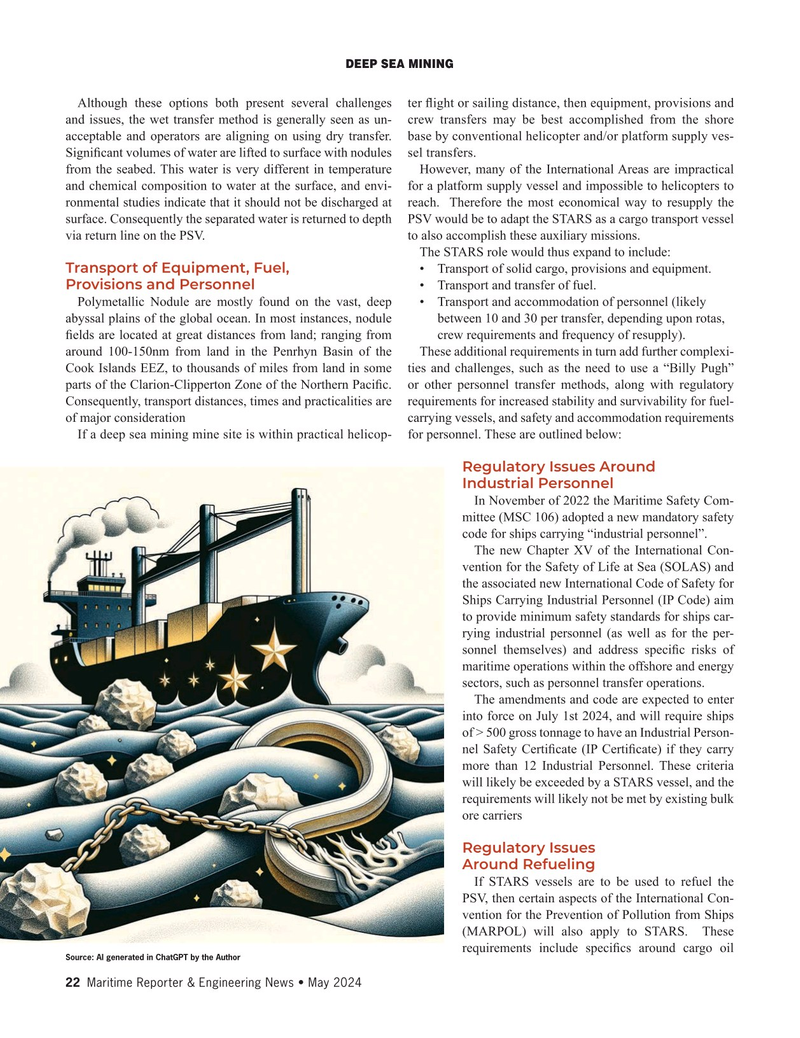
Page 22: of Maritime Reporter Magazine (May 2024)
Read this page in Pdf, Flash or Html5 edition of May 2024 Maritime Reporter Magazine
DEEP SEA MINING
Although these options both present several challenges ter ? ight or sailing distance, then equipment, provisions and and issues, the wet transfer method is generally seen as un- crew transfers may be best accomplished from the shore acceptable and operators are aligning on using dry transfer. base by conventional helicopter and/or platform supply ves-
Signi? cant volumes of water are lifted to surface with nodules sel transfers. from the seabed. This water is very different in temperature However, many of the International Areas are impractical and chemical composition to water at the surface, and envi- for a platform supply vessel and impossible to helicopters to ronmental studies indicate that it should not be discharged at reach. Therefore the most economical way to resupply the surface. Consequently the separated water is returned to depth PSV would be to adapt the STARS as a cargo transport vessel via return line on the PSV. to also accomplish these auxiliary missions.
The STARS role would thus expand to include:
Transport of Equipment, Fuel, • Transport of solid cargo, provisions and equipment.
Provisions and Personnel • Transport and transfer of fuel.
Polymetallic Nodule are mostly found on the vast, deep • Transport and accommodation of personnel (likely abyssal plains of the global ocean. In most instances, nodule between 10 and 30 per transfer, depending upon rotas, ? elds are located at great distances from land; ranging from crew requirements and frequency of resupply).
around 100-150nm from land in the Penrhyn Basin of the These additional requirements in turn add further complexi-
Cook Islands EEZ, to thousands of miles from land in some ties and challenges, such as the need to use a “Billy Pugh” parts of the Clarion-Clipperton Zone of the Northern Paci? c. or other personnel transfer methods, along with regulatory
Consequently, transport distances, times and practicalities are requirements for increased stability and survivability for fuel- of major consideration carrying vessels, and safety and accommodation requirements
If a deep sea mining mine site is within practical helicop- for personnel. These are outlined below:
Regulatory Issues Around
Industrial Personnel
In November of 2022 the Maritime Safety Com- mittee (MSC 106) adopted a new mandatory safety code for ships carrying “industrial personnel”.
The new Chapter XV of the International Con- vention for the Safety of Life at Sea (SOLAS) and the associated new International Code of Safety for
Ships Carrying Industrial Personnel (IP Code) aim to provide minimum safety standards for ships car- rying industrial personnel (as well as for the per- sonnel themselves) and address speci? c risks of maritime operations within the offshore and energy sectors, such as personnel transfer operations.
The amendments and code are expected to enter into force on July 1st 2024, and will require ships of > 500 gross tonnage to have an Industrial Person- nel Safety Certi? cate (IP Certi? cate) if they carry more than 12 Industrial Personnel. These criteria will likely be exceeded by a STARS vessel, and the requirements will likely not be met by existing bulk ore carriers
Regulatory Issues
Around Refueling
If STARS vessels are to be used to refuel the
PSV, then certain aspects of the International Con- vention for the Prevention of Pollution from Ships (MARPOL) will also apply to STARS. These requirements include speci? cs around cargo oil
Source: AI generated in ChatGPT by the Author 22 Maritime Reporter & Engineering News • May 2024
MR #5 (18-33).indd 22 5/3/2024 8:30:41 AM

 21
21

 23
23
